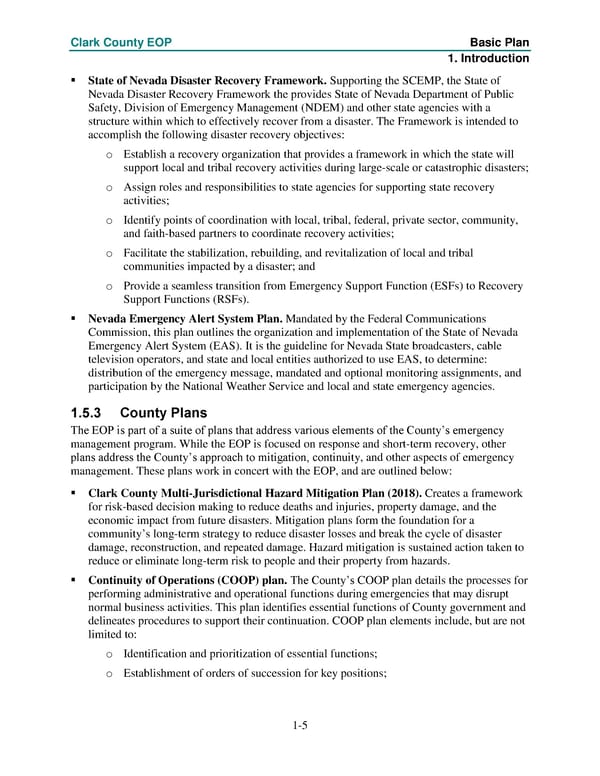Clark County EOP Basic Plan 1. Introduction State of Nevada Disaster Recovery Framework. Supporting the SCEMP, the State of Nevada Disaster Recovery Framework the provides State of Nevada Department of Public Safety, Division of Emergency Management (NDEM) and other state agencies with a structure within which to effectively recover from a disaster. The Framework is intended to accomplish the following disaster recovery objectives: o Establish a recovery organization that provides a framework in which the state will support local and tribal recovery activities during large-scale or catastrophic disasters; o Assign roles and responsibilities to state agencies for supporting state recovery activities; o Identify points of coordination with local, tribal, federal, private sector, community, and faith-based partners to coordinate recovery activities; o Facilitate the stabilization, rebuilding, and revitalization of local and tribal communities impacted by a disaster; and o Provide a seamless transition from Emergency Support Function (ESFs) to Recovery Support Functions (RSFs). Nevada Emergency Alert System Plan. Mandated by the Federal Communications Commission, this plan outlines the organization and implementation of the State of Nevada Emergency Alert System (EAS). It is the guideline for Nevada State broadcasters, cable television operators, and state and local entities authorized to use EAS, to determine: distribution of the emergency message, mandated and optional monitoring assignments, and participation by the National Weather Service and local and state emergency agencies. 1.5.3 County Plans The EOP is part of a suite of plans that address various elements of the County’s emergency management program. While the EOP is focused on response and short-term recovery, other plans address the County’s approach to mitigation, continuity, and other aspects of emergency management. These plans work in concert with the EOP, and are outlined below: Clark County Multi-Jurisdictional Hazard Mitigation Plan (2018). Creates a framework for risk-based decision making to reduce deaths and injuries, property damage, and the economic impact from future disasters. Mitigation plans form the foundation for a community’s long-term strategy to reduce disaster losses and break the cycle of disaster damage, reconstruction, and repeated damage. Hazard mitigation is sustained action taken to reduce or eliminate long-term risk to people and their property from hazards. Continuity of Operations (COOP) plan. The County’s COOP plan details the processes for performing administrative and operational functions during emergencies that may disrupt normal business activities. This plan identifies essential functions of County government and delineates procedures to support their continuation. COOP plan elements include, but are not limited to: o Identification and prioritization of essential functions; o Establishment of orders of succession for key positions; 1-5
 Emergency Operations Plan Page 22 Page 24
Emergency Operations Plan Page 22 Page 24